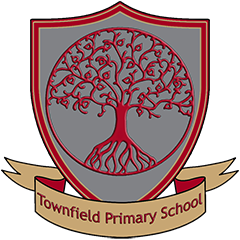Woodland Learning

Woodland Learning

We are privileged at Townfield to have a mature woodland area. Every child has a weekly session in our woodland area, where they have the opportunity to build on skills such as problem solving, resilience, empathy and motivation. They have the chance to use tools, cook on our fire and learn about the flora and fauna in this special area. The woodland is also used to enhance learning in other curriculum areas.
What are the benefits about children being outdoors in green spaces?
Health Benefits
- Studies have shown that children playing in green spaces have better fitness and motor skills, especially balance and co-ordination than non-green spaces.
- Improvement in manual dexterity and physical co-ordination
- Improves vision. Children who play outdoor suffer less from near-sightedness (Ophthalmology 2013)
- Nature allows unstructured play, developing children’s independence and inner strength which helps them tackle future stress (National Ecosystem Assessment 2011)
- Spending time in woods/nature has a positive effect on the immune system (Environmental Health and Preventative Medicine)
Educational Benefits
- Children exposed to nature scored higher in concentration and self discipline and had improved awareness, reasoning and observational skills. They also did better in reading, writing, maths and science and showed improved behaviour Aric Sigman (2007)
- Children with ADHD learn better when out in nature (Journal of Attention Disorders 2008)
- Improves children’s ability to assess risks and discover.
Stewardship of Our Planet
- To raise children who will be future decision makers who will take responsibility for caring for our planet.
- Frequent childhood experiences in natural places encourages a positive attitude towards the natural world into adulthood.

Why is it so important that we provide outdoor learning opportunities at school?
Research shows that children are not getting outside enough!
A National Trust study in 2008 found:
- Since 1970 children’s radius of activity has declined by 80%.
- Fewer than 1 in 10 children regularly play in wild places.
A Keep Britain Tidy study in 2018 discovered:
- Only half of children have never climbed a tree or played a game of Frisbee.
- Less than 10% of primary school children visit the park once a month.
A health survey for England in 2015 reported:
- Only 9% of 2 – 4 year olds meet guidelines of at least three hours physical activity a day
- 80% of pre-school children do not even manage one hour.
- Only 19% of children age 5 – 15 manage at least one hour of moderately intensive physical activity a day.
The impact of this will be even greater as a result of the Covid19 pandemic.


How is a woodland learning session structured?
Warm up
To engage the children and warm them up whatever the weather, the session begins with physical activity e.g. stuck in the mud, hide and seek.
Huddle
Following the warm up, the children meet around the fire circle and woodland leaders give and overview of the session.

Children then all have opportunity to take part in three different learning experiences:
Fire circle time
During this time the children take in part in a mindfulness activity, share a book, take part in music (singing and performing with instruments) and learn about fire skills, including how to cook.

Guided Learning
Children work in small groups with an adult to develop knowledge and skills linked to a curriculum area/forestry skill. These include:
- PE/PSHE e.g. team building activities
- DT - including forest shelter building, learning to tie knots, use forestry tools and cooking on a fire.
- Science e.g. habitats, minibeasts, plants
- Maths e.g. measures – length, perimeter
- Art – e.g. natural sculpture
- Geography navigational skills, maps e.g. orienteering
Planning has been developed from Nursery to Y6. Knowledge and skills are progressive and link to curriculum milestone documents as well as a ‘Forestry skills’ milestone document.
Art
Clay sculpture Leaf art


Maths
Measuring


DT
Using tools


Science
Minibeasts - classification

PSHE/PE
Team building activities

Child Led Exploration
The woodland learning environment provides lots of opportunity for children to explore, practise and embed previously learnt knowledge and skills from the curriculum, as well as develop character and interpersonal skills.
Some activities that are available include:
- tree climbing
- gardening
- mud kitchen,
- den building,
- small world/construction,
- tyre swings,
- writing station,
- performing
- role play
Physical play Role play


Tree climbing Tyre swing


Huddle
At the end of the session children return to the fire circle to share and reflect on learning during the session
What should my child wear?
Children should wear their Activity Uniform (combined PE and Woodland uniform). Please ensure your child is dressed appropriately for Woodland Learning days as if they do not attend school in the correct clothing, they will not be able to take part in Woodland Learning for health and safety reasons. As the unpredictable nature of the whether means even in warmer months, we can experience heavy rainfall or low temperatures, please ensure your child arrives at school with the most appropriate clothing for the weather on that day.
Below is a list of uniform items your child will need to protect their clothes during Woodland Learning lessons. Being correctly dressed means your child is free to enjoy and explore as much as possible.

|
Spring / Summer Months |
Autumn / Winter Months |
|
Waterproof drawstring bag containing wellies* |
Waterproof drawstring bag containing wellies* |
|
Long sleeved t-shirs / Waterproof overclothing** |
Waterproof overclothing** |
|
As determined by weather |
|
|
Sun Cream |
Base layers to keep children warm |
|
Sun hat |
Additional fleece, outer layer and socks |


* children should not arrive at school wearing wellies and should attend wearing appropriate footwear with a bag containing their wellies to change into toprevent the spread of mud throughout school.
** example waterproof clothing
 Townfield Primary School
Townfield Primary School





